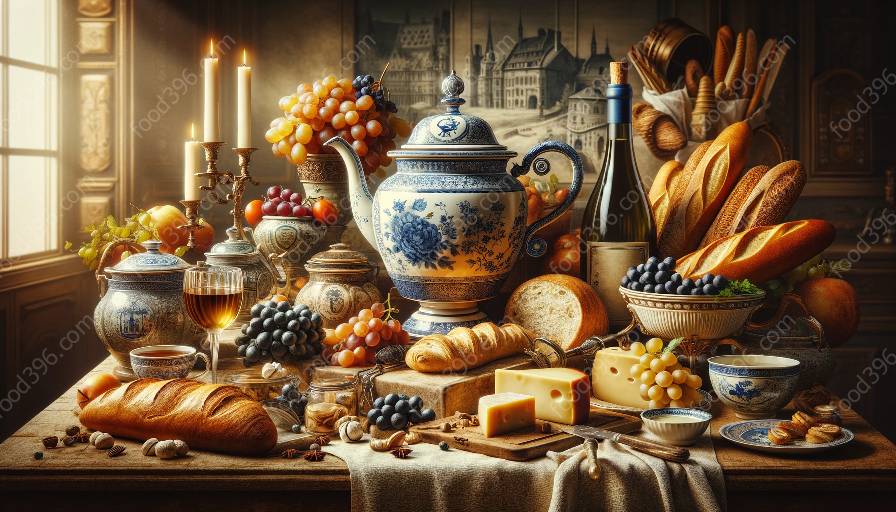French cuisine is celebrated around the world for its rich and diverse flavors, which are attributed to a wide variety of unique ingredients. The history of French culinary traditions provides a deep understanding of the incredible flavors that have made this cuisine so beloved.
French cuisine has been heavily influenced by historical events, regional produce, and cultural exchanges. This article will delve into the fascinating world of French culinary ingredients and flavors, providing insights into the key components of this renowned cuisine.
The History of French Cuisine
The history of French cuisine is a reflection of the country’s rich culinary heritage, developed over centuries. French cuisine has been influenced by various cultures and historical events, resulting in a diverse and vibrant culinary tradition.
It was during the Middle Ages that French cuisine began to take shape, influenced by the culinary traditions of the various regions of the country. The influence of Italian and Arab culinary practices during the Renaissance period further enriched French cuisine with new ingredients and flavors.
The reign of Louis XIV saw the establishment of the first professional kitchen in the Palace of Versailles, which contributed to the refinement of French cuisine. The subsequent French Revolution brought about significant changes to the culinary landscape, leading to the emergence of modern French cooking techniques and the use of innovative ingredients.
French cuisine continued to evolve and gain international recognition throughout the 19th and 20th centuries. Today, it stands as a paragon of culinary excellence, with its traditional dishes and innovative recipes continuing to captivate food enthusiasts worldwide.
French Culinary Ingredients
French culinary ingredients are characterized by their diversity and the emphasis on using high-quality, fresh produce. A wide range of fruits, vegetables, meats, seafood, and dairy products are integral to the creation of authentic French dishes.
Herbs and Spices
Herbs and spices play a pivotal role in defining the flavors of French cuisine. Herbes de Provence, a blend of aromatic herbs such as thyme, rosemary, and oregano, adds a distinctive Mediterranean flavor to dishes. Other essential herbs include parsley, tarragon, chives, and basil, each contributing unique flavors to French recipes. Spices such as saffron, nutmeg, and cinnamon are also commonly used to enhance the complexity of flavors in classic French dishes.
Butter and Cream
Butter and cream are indispensable ingredients in French cooking, adding luxurious richness and depth of flavor to sauces, pastries, and desserts. Beurre blanc and beurre noisette are classic French sauces made with butter and are renowned for their velvety texture and exquisite taste. Crème fraîche, a thickened cream with a slightly tangy flavor, is frequently used to enrich savory and sweet dishes.
Cheese
Cheese holds a revered status in French cuisine, with an extensive selection of artisanal cheeses contributing to the myriad of flavors. From creamy bries and tangy Roquefort to pungent Époisses and nutty Comté, French cheeses are integral to traditional recipes and are often enjoyed as standalone delicacies.
Wines and Spirits
France is renowned for its world-class wines and spirits, many of which are vital components of French cuisine. The diverse wine regions of France produce varietals that complement and elevate the flavors of different dishes. From the rich red wines of Bordeaux to the sparkling champagne of the Champagne region, the use of wine in cooking is a hallmark of French culinary tradition.
Seafood and Poultry
The coastal regions of France boast an abundance of seafood, with fresh fish and shellfish playing a prominent role in the country's cuisine. Mussels, oysters, sea bass, and sole are often featured in traditional French seafood dishes, showcasing the flavors of the sea. Poultry, particularly duck and chicken, are staples in French cooking, offering versatility and distinctive flavors that are central to many classic recipes.
Flavors in French Cuisine
The flavors of French cuisine are a harmonious blend of tradition, innovation, and regional influences. The careful balance of savory, sweet, acidic, and aromatic notes creates a sensory experience that is both comforting and exhilarating.
Umami Richness
French cooking emphasizes the use of ingredients that contribute to deep, savory flavors, often referred to as umami. Ingredients such as mushrooms, aged cheeses, and slow-cooked meats impart a profound richness to French dishes, creating a satisfying and wholesome dining experience.
Fruit-forward Sweetness
French desserts and pastries are celebrated for their delicate sweetness, often derived from ripe fruits and natural sugars. Apple tarts, berry-filled pastries, and citrus-infused custards showcase the vibrant flavors of seasonal fruits, providing a refreshing and luscious end to a meal.
Balanced Acidity
Acidic elements, such as vinegar, citrus juices, and wine, are used to balance and lift the flavors of savory dishes in French cuisine. The judicious application of acidity enhances the complexity of flavors, creating a well-rounded and elegant taste profile in dishes.
Aromatic Bouquets
Aromatic herbs, floral infusions, and fragrant spices contribute to the captivating bouquets that define French cuisine. From the heady aroma of Provencal herbs in stews to the delicate fragrance of lavender in pastries, the use of aromatics adds an ethereal quality to the flavors of French dishes.
Exploring the world of French culinary ingredients and flavors provides a deep appreciation for the history, traditions, and cultural influences that have shaped this celebrated cuisine. From the bountiful produce of the countryside to the opulence of royal palaces, each ingredient and flavor in French cuisine tells a tale of culinary mastery and sensory delight.

